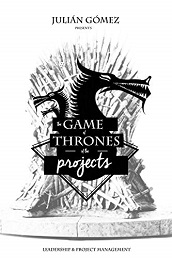27
2020
Interview APGP: What to do when your project becomes a crisis with Stijn Pieters and Robbert Meulemeester
Léelo aprox. en 8:06 minutos.
We recover a pending interview of the VI jornadas sobre Dirección de Proyectos organized by the Government of La Rioja and ThinkTIC in collaboration with APGP that have become even more topical with the current crisis of SARS-CoV-2.
This interview is about crisis and projects and we are pleased to bring you Stijn Pieters, crisis strategist, and Robbert Meulemeester, crisis advisor: What to do when your project becomes a crisis.
Much to learn and much to borrow for our projects.
At the end you can watch the video of the lecture they gave with two hands at the project management conference organized by the Government of La Rioja.

Stijn Pieters is a crisis strategist who specialises in risk and crisis management for companies and governments. He is co-founder and managing partner of PM • Risk Crisis Change, an agency specialised in crisis management and communication.
He has a background in digital communication, strategic communication, public relations, social media strategies, crisis communication, crisis management and disaster management. He holds a Postgraduate in disaster management, Campus Vesta (University of Antwerp). In his dissertation he covered the pre-crisis conditions for effective learning during crisis communication simulations in organisations.
Drive your projects to success
Stijn is co-founder of the CIP Institute, a collaboration platform that advocates research and development in the field of risk and crisis management. He is an active member of the Federal Belgian Crisis Communications Response Team. Stijn is also an author and frequent lecturer in risk & crisis management and crisis communication.

Robbert Meulemeester is a crisis advisor and coordinator at PM • Risk Crisis Change who specialises in crisis intelligence, external perception analysis and sentiment analysis, scenario building and the editorial work process during a crisis. At PM he is a consultant on training and simulations for crisis management and communication teams, digital communication, marketing strategies and media handling.
Robbert is also an author and frequent lecturer in crisis communications, digital marketing, social media and entrepreneurship. In the past he lectured at organisations and academic institutions such as Antwerp Management School, the Business Continuity Institute, University of Leuven, University of Hasselt and more.
Well, let’s go with the questions:
Julián Gómez: Would it be oversimplifying to say that a crisis is a matter of communication?
Robbert: Yes and no. A crisis could be anything, whether it be an operational issue (eg. a fire), a policy issue (eg. layoffs) or a communication issue (eg. rumor about your organisation). On the other hand, communication is a major element of crisis management. However, we do have to make a distinction between coordination and information exchange, which can be seen as internal communication between people that are dealing with the issue, and communication for those affected and involved. Communication is a broad term and, in that sense, it is not completely wrong to say that dealing with a crisis is a matter of communication.
Stijn: I agree. I always say that the broad term ‘communication’ includes coordination, which is different parties listening to and aligning with each other a specific topic. In that sense, your statement is true. Coordination, and thus communication, is a vital part of crisis management.
Julián: For someone who is an expert in crisis management, the agile paradigms of project development must be something too static, since they live in Normal Chaos. Do crises demand a continuous adaptation to the unknown? What are the keys to do it successfully?
Stijn: I like to apply agile paradigms by Philippe Husser (2017) to emergency situations (which are situations that can eventually lead to a crisis). Husser plots different styles of agile project management on two axis (simple vs. complex and certain vs. uncertain), and I find it truly interesting to plot different ways of managing a crisis on those axis, too. I am convinced that a discussion with Husser would deliver a valuable contribution to the domain of crisis management, as a crisis typically unfolds within the chaotic and the unknow (not on the axis).
Of course, crisis is a catchall term. A crisis can ironically be quite simple to resolve, in which case we do not need to resort to a ‘new temporary organisation’ as described in crisis plans. The board or executive team then has to make some decisions and implement them consistently. Other crisis situations, however, are very chaotic, leaving everything within ‘the unknown’.
Robbert: As Stijn mentions, there’s still some research to be done to determine how organisations can adapt to the unknown, but we already have some ideas. Normal Chaos research by Dr. Mike Lauder and Dr. Hugo Marynissen indicates that unstable environments require organisational flexibility. For crisis teams, this means that they should be aware of their capacity and competences, and that they should use these resources to form agile crisis teams that can work autonomously and make decisions based on simple principles. Add to that that they should pursue coordination and work towards the solution in a step-by-step way, and that gives you a basic understanding on how to deal with the unknown.
Julián: Stakeholder management must be one of the pilars of crisis management. On occasion you have mentioned tools such as informal conversations in order to manage them conveniently. How is this tool used when managing a crisis globally?
Robbert: Research by Dr. Hugo Marynissen indicates that there are two ‘circuits’ in every organisation: a formal circuit of procedures, official meetings and feedback processes, and an informal circuit such as afterworks, discussions on social media and watercooler talk. It is the informal circuit that, to a large extent, determines how people behave within the organisation. Hence, if you really want to know the perspective, information needs, concerns or sentiment of your stakeholders in times of crisis, you cannot solely focus on the formal part. By analysing informal processes, by using social media or by simply listening to conversations that are happening, crisis teams can gather data on which they can build a strategy on how to deal with their stakeholders in an effective way.
Stijn: Robbert’s answer comes from an internal perspective. How to apply informal conversations within the organisation as a tool for crisis management? Of course this is also valid for all stakeholders, be it regulators, suppliers, clients or the general public. Informal conversations give us insights in how people feel, what their biggest uncertainties or questions are, and how big the impact on stakeholders is. It is crucial to have that intelligence, as it will make your communication more effective, reducing pressure on the organisation and therefore freeing up mental space for decision making on crisis management and business continuity.
Julián: What would be the steps to prepare our company/project for a crisis.
Robbert: That is a loaded question so we keep it rather short for this interview. In short, we recommend to start by identifying key people within your organisation for crisis management and crisis communications. Start by making generic and practical agreements on topics like notification, organisation and coordination. Avoid the pitfall of doing too much at once: instead of organising an intense day of exercising with the newly formed group, organise a few short and snappy sessions. In later iterations, involve new people such as back-ups, certain specialists or middle managers to slowly work on your organisation’s capacity and competences to deal with crisis. Do not forget to formalise the most important agreements in your crisis plan, but be aware of the fact that it is the people that have to save your organisation in crisis, not your plan.
Stijn: You asked for steps, so I’m going with these:
- 1. Assess what risks and benefits your organisation cares about. Be aware that this is a multi-dimensional mental exercise with lots of internal (and external) stakeholders.
- 2. Decide which layers of defense you are willing to implement (contingency planning).
- 3. Realise where your organisation remains vulnerable. This gap should give your organisation an estimate of how much crisis preparedness you should implement.
Julián: In today’s digital world where any event is viralised in a matter of seconds and be exposed to the opinion and reaction of millions of people, which tool should be our greatest ally: the lie, the truth, transparency, wring the bundle, or another?
Stijn: Having been in many crisis situation, I know that you should obviously never lie. On the other hand, I also realised that the general public cannot cope with total transparency. (I don’t know what wringing the bundle means, but it doesn’t sound good, so be wary of it ;-)) Your biggest ‘ally’ should be to listen to and align with those that are affected the most. For crisis leaders, my message would be to get off your high horse and get your hands dirty! Listen to those affected and involved, align internally, strategise and consistently implement the strategy in a step-by-step way. Most of the time I see the best crisis managers following personal values and a core set of crisis principles to do so.
Robbert: I would like to add something on the topic of total transparency. It is true that the need for information and time pressure in times of crisis have never been higher as it is today. At PM we always say that organisations should ‘avoid looking shifty’, which means that they should avoid raising red flags with their stakeholders. Therefore, we recommend to never lie, stay humble, be the bigger person (even when people are bashing your organisation left, right and center) and to be transparent enough to help people make sense of the situation. But as far as the digital world and its viral tendency go, it is just something we have to take into account as part of the context; there’s not much we can change about that.
Thanks Robbert and Stijn!
Here you can see the keynote of Stijn Pieters and Robbert Meulemeester:

Consigue Más de 100 Libros gratis
Suscríbete a nuestro newsletter por email y conseguirás Más de 100 Libros Gratis sobre Gestión de Proyectos, Innovación, Emprendimiento, Empresa, etc. directamente en tu correo
Últimos artículos de Julián Gómez (ver todos)
- El Último vídeo del viernes del año: Vuela como un dragón - hace 4 meses
- Ultimo video del viernes del año: Sé diferente - hace 1 año
- Vídeo del viernes: Kadenko, una luz en la navidad - hace 1 año










[…] Who are? […]